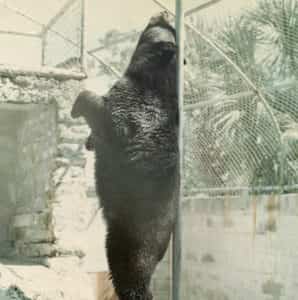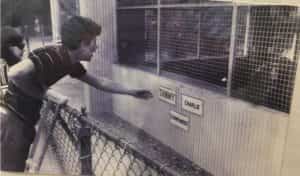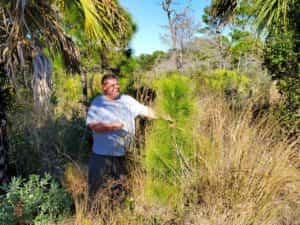Vintage St. Pete: Boyd Hill Nature Tail Zoo
In the aftermath of 2017’s Hurricane Irma, Boyd Hill Nature Preserve Operations Foreman Howard Saytor and his maintenance crew were digging out the root system of an old tree that had blown over.
Their shovels unearthed a collection of bone fragments. And then – a sizeable pair of yellowy-white fangs.
It was, Saytor surmised from the size of the teeth, what remained of Sam, one of two Florida black bears that had lived in a wire-and-concrete cage at the long-ago Boyd Hill Nature Trail zoo.
Sam died in 1976.

Sam the black bear in happier times. SPMOH photo.
“I remember people saying that if some of the animals had passed on after a long, natural life, they actually buried them on the property somewhere,” recalled Saytor, who’s been with the city-owned preserve in south St. Pete for two decades.
The zoo was located near the entrance of the 245-acre park, on the southern edge of Lake Maggiore (formerly Salt Lake), 380 shallow acres of brackish water. It was named for Boyd Hill, who’d been parks superintendent from 1954 until his death from a heart attack in 1957.
Hill’s vision for a natural oasis in the middle of a growing city – the term “urban sprawl” wasn’t yet in wide usage – was of winding foot paths through pine thickets, sandhill uplands and the marsh and wetlands buffering Lake Maggiore, which had flowed naturally in and out of Tampa Bay until a dam was built in the 1940s.
“The atmosphere of serene peace and quiet is almost tangible,” St. Petersburg Times columnist Dick Bothwell wrote about Boyd Hill’s park in 1958. “And this will be even more priceless an asset in the day when Pinellas is solidly settled, for the original Florida is going fast.”

African chimpanzees Charlie and Tammy, zoo residents from the beginning, were taunted for 20 years. Boyd Hill Nature Preserve photo.
The zoo, however, was noisy. At its peak in the late 1960s, there were an estimated 500 parakeets inside a large wire flight cage (vandals eventually cut through the wire, and most of the birds escaped into the St. Pete breeze). Monkeys howled. Peacocks roamed the grounds, screaming incessantly.
Admission was just a dime, and so the place was swarming with kids every weekend. Schools made field trips to “Nature Trail” (that’s what everyone called it) during the week.

The Old Lady Who Lived in a Shoe slide, circa 1959. Boyd Hill Nature Preserve photo.
“It was great,” remembers Saytor, who was himself a local kid in the 1960s. “Where else were you going to see chimpanzees and bears and stuff? And alligators.
“It was pretty adventurous for the time. There really wasn’t that much to do in St. Pete in that era. This was like a little mini-theme park.”
Tallahassee attorney George Meros grew up in the neighborhood around Boyd Hill, and fondly remembers it as “just a bike ride away” for him and his siblings.
“It was fun, it was safe, and it was just a great part of growing up in St. Petersburg,” Meros says. “Nice people. The most modest of zoos, but plenty fun for kids our age.”

SPMOH photo.
Because the science of animal husbandry was still in its infancy, little thought was given to the captive animals’ habitats. Raccoons, deer, alligators, black bears and other indigenous Florida wildlife was caged behind chain-link and chicken-wire alongside non-natives – coata mundi, an ocelot, several species of monkey, an agouti, prairie dogs, the chimps and a pair of South American kinkajous, commonly called “honey bears.”
Visitors got used to seeing the animals pacing back and forth in their cramped quarters, all day long, bored and frustrated. The monkeys masturbated and threw feces. Kids learned to dodge.

SPMOH photo.
The menagerie grew over the years; many of the exotic animals were donated to St. Petersburg’s sole “zoological park” because their owners just couldn’t, or didn’t want to, deal with them any longer.
By the mid ‘70s, Nature Trail zoo was also overrun with penned rabbits and free-roaming ducks and chickens – Easter “gifts” that had grown up and weren’t so cute any more – and with prodigiously-breeding guinea pigs.
In 1975, Boyd Hill Nature Trail zoo was cited by the Game and Freshwater Fish Commission for overcrowding, insufficient cage sizes and a number of other violations.
The zoo, it was also noted, was “odoriferous.”
Almost everybody hereabouts has oohed and aahed over the animals at Boyd Hill Nature Park zoo. Many a child has had his first real introduction to wildlife there. Lately, though, more and more animal lovers have wandered among the crowded cages with an uneasy feeling that this is a far cry from what nature intended. There’s no doubt about it.
St. Petersburg Times editorial
July 21, 1975
The chimpanzees sometimes escaped and caused havoc. Snakes, turtles and other animals were repeatedly stolen. Vandals broke in and clubbed flamingos, rabbits and guinea pigs to death.
The City decided then and there to get out of the roadside attraction business altogether. Noell’s Ark Chimp Farm, near Tarpon Springs, bought 100 of the Boyd Hill animals (including 10 goats, four coata mundi and one kinkajou) for $763 in 1977.

Boyd Hill Nature Preserve photo.
Strangely, according to records the “farm” did not take Charlie, the remaining chimpanzee. Charlie’s longtime mate, Tammy, had died at Boyd Hill the year before.
After numerous federal animal welfare violations, Noell’s Ark was shut down in 1999.
A big-cat breeding facility in Bushnell, Savage Kingdom, purchased the ocelot, an agouti and two foxes. Savage Kingdom was eventually closed by the state government under similar circumstances.
In 1978, the Boyd Hill Nature Park zoo was bulldozed, as part of a massive re-purposing of the property. On (re) opening day, Dec. 14, 1980, Boyd Hill’s widow was among the local dignitaries cutting the ribbon on an interpretive nature center, with a fully-stocked library, classrooms, exhibits and laboratories.
The emphasis was now to be on “natural” Florida. However, the team designated by the City to make this transformation happen paved the main trails over with asphalt.

The asphalt was removed after Howard Sayter signed on as foreman. Boyd Hill Nature Preserve – which is operated and maintained by the Department of Parks and Recreation – is his baby, and he has dedicated himself to its future.
“If you lose it,” he exclaims, “you lose the biodiversity of what’s left. Then you’re going to have to go 50, 100 miles away from here to see this. This is a very unique place. I look at Boyd Hill just like a New Yorker would look at Central Park. That’s exactly what this is.
“People don’t realize it. This is going to be St. Pete’s Central Park. People still need green space, to go out and walk around, see Florida as what it was before man was here.”
A small staff of rangers, biologists and volunteers keep the place running out of the education building (South Branch Library was relocated to Pinellas Point in 2002). There’s a fully-licensed raptor rehabilitation center, where Floridian birds of prey deemed unable to fly, or fend for themselves, live out their days inside airy, state-of-the-art flight pens.
It’s a far cry from the old zoo, with its primitive, concrete captivity cages.

Photo: City of St. Petersburg.
Because it includes more than six miles of trails through five distinct habitats – hardwood hammocks, sand pine scrub, pine flatwoods, willow marsh and lake shore – Boyd Hill is now one of the most desired hiking destinations in the state. The preserve is also part of the Florida Fish and Wildlife Conservation Commission’s Great Florida Birding Trail.
Howard Saytor sees his mission plainly: To erase nearly all of the short-sightedness that went into planning the place back in the 1940s and ‘50s. To restore the bio-diversity that was lost, or at least plowed over, when man began interfering.
“I’m trying to get the land back to the way it was,” he explains. “Boyd Hill introduced a lot of exotic plants out here. It seems to me he was trying to mimic Sunken Gardens. Because Sunken Gardens was really the only thing … and Webb’s City, the world’s biggest drugstore.”
When Saytor arrived, the trails were overgrown. He was stunned to see stocky saw palmettos grown to a height of 12 feet, competing with slash pines and loblolly. Exotics trees and vines were everywhere. “The whole system was out of balance.”

Photo: City of St. Petersburg.
So began a dedicated restoration project – to take out, branch by root, all of the exotic, non-Florida plant species, introduce controlled burning, restore the natural water flow from the park to oxygen-starved Lake Maggiore by eliminating storm drain runoff from neighboring streets, and filling in the plethora of purposeless “mosquito ditches” dug by the crews back in Boyd Hill’s day.
All of it is a work-in-progress.
Hundreds of plant species that would not normally be found in Florida have become the bane of Howard Saytor’s day-to-day life at the park. He can name every one of them, where they came from, what damage they can do. They grow like weeds – which, after all, they are.

“People don’t realize it,” says Boyd Hill Foreman Howard Saytor. “This is going to be St. Pete’s Central Park.” Photo by Bill DeYoung.
“If we want to keep a true representation of Old Florida, we have to remember that invasive species become monocultures – they displace the natural vegetation,” Saytor explains. “Which in turn displaces the native wildlife. So it’s the complete collapse of a system.”
It’s an ongoing battle, slashing, burning and ripping out the exotic flora to make conditions optimal for the majestic live oaks, pines, sable palms, red maples, bay, cedar, cypress and sugarberry trees. It’s also a horticulturist’s dream, to rebuild a healthy world for his beloved plants.
“I’m even trying to bring trees back that historically were here, and had been eradicated,” Saytor says proudly.
The ripple effect, since restoration work began, is obvious. Because the decades’ accumulation of unchecked undergrowth has been removed through controlled burning – mimicking a natural process – wild hawks, owls and even eagles are making a comeback. The reason? They can now swoop down on prey animals because there’s so much more exposed ground.
Likewise, rangers are starting to see more and more newly-hatched gopher tortoises; the vegetarian reptiles’ natural food – at ground level – has become much more plentiful since the sunlight reached it.
According to Barbara Stalbird, the City’s Natural and Cultural Areas manager, once Boyd Hill’s land use designation was changed from “Recreational Open Space” to “Preserve,” the chances that the park would ever be sold to developers – local environmentalists’ worst nightmare – went from slim to not-at-all.
“Boyd Hill is a charter park, meaning we wouldn’t be able to do any kind of use change unless we got a vote from the citizens,” she says. “Either way, the park is under extreme protection.”
Originally published in December 2019, this story appears in the book Vintage St. Pete: The Golden Age of Tourism – and More (St. Petersburg Press).
Friends of Boyd Hill Nature Preserve Page

A view from the bridge: Lake Maggiore gives way to St. Petersburg’s downtown skyline. Photo by Bill DeYoung.








Collier F. McCall
December 5, 2020at9:02 pm
I enlisted in the Air Force shortly after graduation from St. Pete High in July of 1953. There was no park on the south shore of Lake Maggiore at that time. The only “civic” event I can remember at Lake Maggiore was the Soap Box Derby on the only hill in St. Pete. Upon retirement from USAF in 1974 I came back to St. Pete and found that the small city that I had left twenty some years ago wasn’t the place I had left. But, I did learn of the park on the shore of Lake Maggiore near Lakewood Estates and took my children to show them something of the St. Pete where I was born.
Don’t loose that park people. I can remember when some of the shore there was a city DUMP!